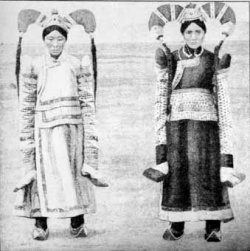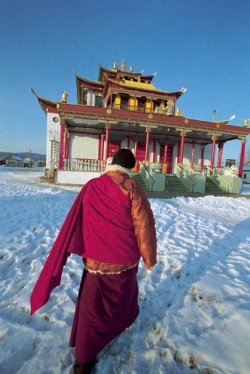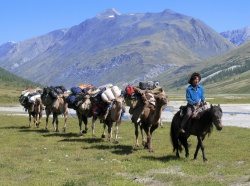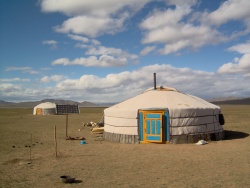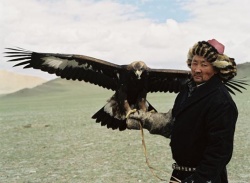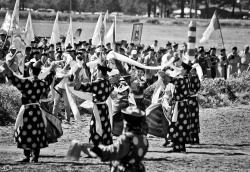Surviving Modernity in Mongolia by Vesna Wallace
Editor’s introduction: This succinct presentation by one of the world’s great scholars of Mongolian Buddhism summarizes the challenges that Buddhism has faced and continues to face in Mongolia. Amid historical reconsideration and revisionism – and continuing propaganda – it is important to acknowledge and understand, as Dr. Wallace conveys, the enormity of repression faced by Buddhism, as Mongolia’s longstanding religion and cultural tradition, during seven decades of Soviet socialist control. This included the summary execution of many thousands of monks and lamas, the closing and also the physical destruction of all but a tiny handful of the country’s 3,000 temples, and virulent public vilification of Buddhist religious practices.
Now awash in a boom of free market economic development, Mongolia faces, as Dr. Wallace describes it, two complementary forms of modern influence: one historically communist, with a significant continuing influence in the present, and the other capitalist. In the mix, Mongolian Buddhism struggles to assert and reinvent itself amid official ambivalence (and heavy taxation) and zealous Christian prosyletization that continues to borrow from anti-Buddhist communist propaganda. Despite these challenges, echoing a statement by Buddha himself that is referred to by Dr. Wallace in her conclusion, the Buddhist legacy continues to vibrantly reassert itself, and to redefine itself with resilience, in contemporary Mongolia.
When we think of modernity in traditional Buddhist regions, we are reminded that these regions have known different kinds of modernity. The traditionally Tibetan Buddhist regions in Mongolia and Russian Inner Asia encountered a modernity brought by the winds of a communist revolution in the early 20th century which secularized the Buddhist world-view and promoted the ascendancy of scientific materialism.
This communist modernity was far more detrimental to the Buddhist tradition than the kind of modernity in which the Tibetan Buddhist tradition finds itself today in different parts of the world. The modernity of the communist revolution, which forcibly imposed secular culture, values, and a way of life upon Mongolian society by means of systematic prohibition of religious freedom, anti-Buddhist propaganda, and the destruction of traditional Buddhist institutions and education, resulted in the tradition’s demise, the effects of which continue to this very day. Thus, contemporary Buddhist tradition in Mongolia finds itself caught in a collision of the effects of communist modernity with a contemporary modernity that is dominantly characterized by materialism, individualism, and capitalism. The impact of two types of modernity, which began with the democratization of Mongolia in the late 1980s, has generated a crisis of modernity that is arguably unique among the post-communist societies.
In this short paper I will limit my comments to a few of the areas affected by the impact of these two kinds of modernity. I will briefly mention the ways that they have influenced Buddhism in Mongolia and some measures taken by Mongolian Buddhists to counteract their undesirable effects.
Prior to the communist revolution, there were about 850 Buddhist monasteries in Mongolia with 3,000 temples, comprised of approximately 6,000 buildings and accommodating nearly 100,000 monks. Buddhist monks made up about one-tenth of the Mongolian population within the first two decades of the 20th century. Traditional Buddhist beliefs and practices permeated every aspect of Mongolian life, and ties with Buddhism in Tibet were intimate. With the formation of the Mongolian Peoples’ Revolutionary Government (MPR), which took place in July of 1921, all this changed within two decades.
The MPR government’s effort to diminish the influence of Buddhism began with the weakening of monasteries economically, which at that time had considerable wealth in terms of livestock. It imposed heavy taxes on monasteries, and this taxation has remained in effect even during the period of democratization. Contrary to the persistent misperception of Buddhist monasteries as repositories of wealth, until very recently, the reestablished and severely under-funded Buddhist monasteries continued to pay twelve different kinds of taxes to the government. In contrast, foreign, well-funded missionary organizations representing other faiths, which are often seen in the public eye as religions of the modern and successful, have been exempted from most of the taxes to which Buddhist monasteries have been subjected.
Communist modernity, steered by the Mongolian Peoples’ Revolutionary Government Party (MPRP), heightened anti-religious propaganda, disparaged Buddhist beliefs as “unrealistic, cruel, deceptive, and without future,” while promulgating their revolutionary ideology as “realistic, true, close to life, and always supportive of workers’ rights.”[1] The MPRP pursued anti-Buddhist propaganda through film, radio, and printed materials, which accused Buddhist monasteries of damaging the national productive force. By 1934, the MPRP had produced twelve feature films that portrayed Buddhist ideas and practices as corrupt and shameless, while promoting the people’s revolution as kind and beneficial, striving to protect the common man from exploitation by high-ranking lamas. By 1937, there were twelve traveling cinemas in Mongolia, and more than a half million people in the countryside saw the party’s politically indoctrinating films. In 1936, the MPR government printed 3,000 copies of its first anti-Buddhist magazine and disseminated it among the lower-ranking lamas.
After Stalin solidified power in the Soviet Union, the economic reforms imposed on monasteries by the MPRP were replaced by the methodical secularization of Buddhist institutions, the destruction of Buddhist buildings, and the persecution of lamas. By 1938, 6,000 monks were imprisoned, and tens of thousands were forcibly secularized, exiled, and executed. Over 10,000 lower-ranking monks were forced into labor in animal husbandry, factories, road and bridge repairs, construction works, carpentry, and transportation, while others were placed into 120 craft-cooperatives. By 1940, Buddhism as an institutional religion entirely disappeared in Mongolia – until a temple at the Gandan monastery reopened in 1945 on the decree of Stalin himself, especially as a showpiece for visitors. A small number of surviving elders who continued to perform services there held the tradition’s torch alive. In consequence, in 1969, the monastery became home to the Buddhist Institute, where elderly lamas taught. Those who became ordained at that time were allowed to wear monastic robes only inside the monastery.
In the earliest phase of the revolutionary period, one of the greatest obstacles the MPR government faced in advancing its revolutionary culture was the lack of support from Mongolia’s youth. The overwhelming majority of Mongolian young men continued their traditional Buddhist education, whereas only a few thousand of them attended the newly established public schools.[2] For this reason, the MPR government devised various strategies to attract and force Mongolia’s youth and lower-ranking lamas into revolutionary activities. The revolutionary party’s endeavor to attract Mongolian youth has not ceased to this day, even though its methods have changed to some degree. In an effort to make itself appealing to youth, it often presents itself as modern, smart, fashionable, and as no longer inimical to Buddhism.
While it is true that the revolutionary party no longer persecutes Buddhism, and, in the fall of 2000, publicly apologized to the Mongolian people for its previous persecution of religion, the weight of history has made many Buddhists mistrust the sincerity of this apology. Some Buddhists see it as a merely symbolic gesture motivated by a self-serving political agenda. Some revolutionary party’s members have professed their faith in Buddhism, for they no longer see it as antithetical to their political views. But there are also those who have displayed their sympathy for Buddhism only at the election time in order to attract a larger constituency.
Experiencing the detrimental effects of communist revolution and of World War Two, in 1969 Venerable Gombojav, then the abbot of Gandan monastery, and Venerable Gomboev, the Head Lama of Buddhism in the Soviet Union, plus Bakula Rinpoche, and others, initiated the founding of an international NGO, called the Asian Buddhist Conference for Peace, which remained to this day, headed by the Venerable Choijamts as its president and by Venerable Bulgan as its secretary. This first Buddhist NGO in Inner Asia facilitated a mutual cooperation among the Buddhists communities who had struggled under the Soviet regime, bringing them into dialogue with Buddhists from other Asian countries at the time when it was very difficult for Mongolians and Russians to travel abroad.
The MPRP’s anti-religious campaigns, which succeeded in damaging traditional Buddhist education and destroying Buddhist cultural heritage in Mongolia, were celebrated by the MPR government at the time as a contribution to bringing modernity and progress to the region. One part of that modernization was the termination of the tradition of maintaining family-clan and spiritual lineages, which were at the core of Mongol life. These lineages were replaced with new identity markers such as the revolutionary party, cooperatives, and other newly instituted social groups. In the pre-revolutionary culture, by contrast, a person who could not list the names of his/her prior seven generations of the family lineage was not regarded as a Mongol, and any monk without affiliation to a lineage or monastery lacked social standing.
Given the replacement of this older system with an ostensibly more modern one, cynicism and suspicion concerning Buddhist institutions and their legacy persist to this day, especially among those educated during the Soviet period in the universities of Moscow and Irkutsk, who now constitute a significant proportion of the Mongolian government employees and country’s intellectuals. One outcome of this distrust is an utter lack of public financial support for Buddhist monasteries, which lack resources for the fundamental needs of monks such as lodging and so on. Hence, one of the present tasks of the holders of the Buddhist tradition in Mongolia is to replace the old communist narrative with the one that is factually balanced and that expresses their willingness and ability to address the current needs and concerns of Mongolian people.
During the pat twenty years, the material and spiritual aspirations of Mongols have also provided fertile ground for the proselytizing activities of foreign missionaries. A significant portion of these missionaries disseminate anti-Buddhist views in ways that resemble those of the old communist revolutionaries, proclaiming, for instance, “We give, Buddhism takes.” A new constitutional law that guarantees freedom of religion has facilitated a continuous influx of diverse religious traditions and New Age groups from Europe, America, and Asia. In 2001, 182 religious organizations were registered at the Mongolian Ministry of Justice and were regulated by the Ministry of Internal Affairs. Among them, were 60 Christian organizations as well as 110 Buddhist ones – with the remaining dozen belonging to the less represented traditions of Baha’i, Shamanism, Islam, and Hinduism.
After a series of suicides among teenage converts to Christianity between 2001-2002, the Mongolian government surveyed foreign missionary organizations in the spring of 2003 and found that 80% of them were not registered at the Mongolian Ministry of Internal Affairs, as required, and that some of them were banned in other parts of the world. In the same year, a large survey conducted among Mongolian youth revealed that 50.3% of those polled acknowledged that religion plays an important role in their lives, while 49.7% said it does not have any impact on their lives. Those who professed Buddhism as their faith constituted 34% of survey participants, and when asked whom they trust most, 20.3% expressed their trust in Buddhist lamas. In this survey, 11% professed non-Buddhist faiths, while 31% declared themselves to be atheists. Moreover, records from 2007 show that while the number of Buddhist centers and monasteries in the country’s capital of Ulaanbaatar decreased to about 30; the number of non-Buddhist religious organizations increased to 300.
The general confusion, lack of self-esteem, and search for identity resulting from the loss of traditionally formed identities are evident nowadays in all levels of Mongolian society. Their effects manifest in widespread anxiety, depression, apathy, alcoholism, crime, bribery, and other forms of corruption. In response to these crippling circumstances, Mongols, especially among the younger generations, have begun to seek solutions to these difficulties and to find meaning in life through modern alternatives.
Due to the oppressive nature of the earlier communist regime, communist modernity did not give rise to the anxiety that is due to the available, wide array of lifestyle choices and future possibilities that are beyond the Buddhist tradition’s control – and that present themselves to the Mongolia of today. Instead, the anxiety of the communist era arose from a lack of alternatives and from the absence of freedom of expression, which necessitated the careful concealment of one’s private Buddhist practices. However, Mongolian concern with the possible disappearance of their Buddhist tradition in the country has been a common experience in response to both types of modernity.
At the present time, there is once again a fear among Mongolian Buddhists that Buddhism may be discarded as irrelevant to the modern world amid Mongolians exposure to an ever-widening array of alternative worldviews, values, and lifestyles. These are variously promoted by materialist atheists, growing Christian fundamentalists, Shamanists, and others. Each of these factions claims its superiority over Buddhism, in many cases expressing overt hostility in their words and actions to its tradition. On Christian and Shamanic radio and television programs, antagonism to Buddhist tradition is commonly expressed, with practices ridiculed and their holders reviled. On occasion, new converts to Christianity and followers of Shamanism have violently attacked Buddhism, destroying stupas in the countryside, burning classrooms at a branch of Gandan monastery in the town of Nalakhi, where quarrels among Christians, Muslims, and Buddhists are common, and committing other acts of violence since the year 2000. The search for a new identity has not been limited to individuals but affects the Mongolian state as well. In its attempts to recreate a Mongolian identity, the state has been unable to ignore Buddhist tradition and symbolism. For many, Buddhism provides an anchor in times of social instability, collective confusion, and the complexity of modern life.
Thus, a garuda – a large mythical bird-like creature which can consume a poisonous snake but not be affected by its poison – has once again become the symbol of Mongolia’s capital. When Mr. Sharavdorj became the Minister of Defense, he revived the worship of Jamsran (Begtse) as a protector of the Mongolian military. Likewise, Vajrapani (Ochirvaany), who is believed to have incarnated as Chinggis Khan, the revered father of the Mongol nation, has again become a protector of the Mongolian state. During the Naadam festivities, in which the glorious imperial history and tradition of Mongolia are celebrated, when the standard-bearers dismount from their horses, they shout: “Hurrah! Hurrah! Hurrah! Our Lord Chinggis Khan, Vajrapani”. Every three years, the new president of Mongolia worships and makes offerings to Vajrapani on behalf of the Mongol state at Otgontenger Mountain, believed to be an earthly home to Vajrapani and his mountainous emanation.
The fact that the Buddhist tradition is surviving modernity against all odds can be attested in many areas of Mongolian public and private life. When the relics of the Buddha were brought to Mongolia in 1993, tens of thousands of Mongols stood in line every day to pay homage. Similarly, when the relics of great Indian and Tibetan Buddhist masters were brought to Gandan monastery several years ago, masses of people came to pay homage and receive blessings.
Interest in the serious study of Buddhism among the youth has visibly increased over the last few years. At the Buddhist Zanabazar University at Gandan monastery, about 100 students, monastic and lay, are currently receiving traditional Buddhist education. When the Dharmacakra Student Club was founded in September of 2000 at the Mongolian National University, it had only four members. By 2004, its membership had grown to 60 students. This year, another 60 undergraduate students are enrolled in Tibetan language classes at the Mongolian National University, and a half a dozen are pursuing graduate degrees in Tibetan Studies. In the Mongolian National University, the study of the history of Buddhism and Buddhist philosophy is also available in the departments of philosophy, religious studies, and Mongolian studies.
Despite the seven decades of religious suppression, the Buddhist faith did not succumb in the minds of resilient Mongols. Monastic education is being revitalized, and in response to Christian missionaries’ methods of attracting youth by offering free English classes, Buddhist centers such as the Foundation for the Preservation of Mahayana Teachings (FPMT) have also started making free English classes available to young people.
Although in the pre-revolutionary period, Buddhist teachings to the lay public were not common, nowadays, they are regular public events in Gandan monastery and in various Buddhist centers. The attendees make up a non-traditional audience that does not passively receive teachings but asks probing and challenging questions and raises issues relevant to life in a modern world.
To counteract the contrastive images of rival groups as modern, fun, and attractive, the Buddhist tradition has felt compelled to demonstrate that it too is not a religion of the backward and conservative, but a modern tradition, to which talented, hip, and famous people also subscribe. An advantage that the Buddhist tradition has over foreign competing groups is its regional history that allows it to reclaim its old power places, pilgrimage sites, and locations linked to the worship of local mountain deities. Buddhism’s long history in Mongolian regions provides it deep roots across the Mongolian countryside even though its traditions were suppressed for 70 years. Those who kept their faith during those trying times have continued to secretly carry out their Buddhist practices, which they do now openly.
The steady progress in the renewal of the Buddhist tradition in Mongolia despite the difficulties and challenges presented by the two discussed types of modernity reveals the ability to survive in adverse conditions and to adapt itself to new social and political realities. This adaptation is not necessarily to the detriment of the tradition but may be regarded as an expression of skillful means that facilitate its rejuvenation and reinvention.
As this conference is concerned in part with the cultural and spiritual identity of Mongolians and the potential outcomes of modernity or possible loss of Buddhist traditions, I would like to conclude with the Buddha’s words spoken to Subhuti in the Vajracchedika Sutra. In that text, the Buddha assures Subhuti (and us) that the teachings of Mahayana will never perish and that there will be always those who will listen to them. He declared the following: “Subhuti . . . in a future time, in the final age…when the time of the destruction of the True Dharma comes to pass, there will be bodhisattvas and great beings endowed with good qualities, ethical conduct, and wisdom, who when the words of such discourses as these are being spoken, will recognize them as the truth.”
Footnotes
Source
Author: Vesna Wallace
academia.edu
